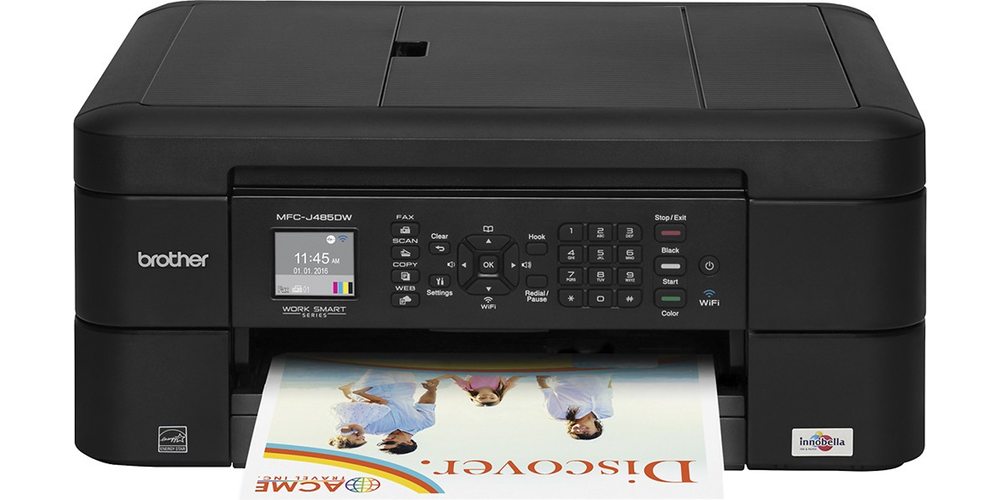

In addition, the MFC-L5700DW sports a relatively standard set of security features that includes Active Directory, Secure Function Lock (so you can restrict usage and functions for up to 200 users), and Secure Print (for assigning PINs to sensitive print jobs). Support for popular cloud and social media sites is extensive, too: both the personal and business versions of Google Drive, Evernote, OneDrive, Dropbox, and Box, as well as OneNote, Google Apps for Business, Facebook, and Flickr. Brother also throws in several cloud apps, such as Office Print (for printing from Microsoft Office), Outline&Copy, Outline&Scan, Easy Scan to E-mail, NoteScan, Office Doc Creator, and CreativeCenter.

Other mobile connectivity options include: Apple AirPrint, Google Cloud Print 2.0, Mopria, Cortado Workplace, and Brother iPrint&Scan. The HP model has an 80,000-page maximum monthly duty cycle with up to a 4,000-page recommended print volume, and the MFC-L5700DW is rated at only 50,000 pages and up to 3,500 pages, respectively.īasic connectivity includes Ethernet, Wi-Fi, and USB, as well as Wi-Fi Direct for making routerless peer-to-peer connections with your mobile device. To get an auto-duplexing ADF from a Brother laser monochrome all-in-one, you'll have to step up to a more expensive model, such as the MFC-L6800DW ($649.99 at Amazon), but the additional cost also gets you a 70-sheet ADF (rather than 50 sheets on both the MFC-L5700DW and the M246fdw). (Opening and reconfiguring a paper drawer, of course, takes the machine out of service.)Īs mentioned, the MFC-L5700DW's 50-sheet ADF cannot scan two-sided originals without your turning them over manually. Not only is this a significantly lower input capacity, but the LaserJet has only three distinct paper sources, compared with the MFC-L5700DW's four, which makes the LaserJet less versatile in terms of how many types of media you can have at the ready at any given time. By comparison, the HP M246fdw comes with a standard capacity of 350 sheets (from a 250-sheet cassette and a 100-sheet multipurpose tray), but you can add only one 550-sheet drawer for a maximum capacity of 900 sheets. Adding two 520-sheet drawers increases paper capacity to 1,340 sheets. If 300 sheets from two separate sources is not enough, you can add up to two 250-sheet ($179.99 each) or 520-sheet ($209.99) cassettes, in any combination.

Standard paper capacity is 300 sheets, split between a 250-sheet cassette and a 50-sheet multipurpose tray. Aside from the touch screen and number pad, the only other buttons are Back, Home, and Cancel, which are context sensitive (they display only when their allotted task is available). The touch screen is customizable in that you can create up to 48 "shortcuts" to perform routine functions, such as printing from or scanning to your favorite cloud site. The control panel consists of a 3.7-inch customizable color touch screen, and when you select Copy or Fax, an otherwise invisible number pad lights up to the right of the display. Design and FeaturesĪt 19.1 by 17.1 by 16.8 inches (HWD) and weighing 36.2 pounds, the MFC-L5700DW ($319.99 at Amazon) is a bit big to fit comfortably on the average desktop and just heavy enough that you might need help getting it out of the box. Because of that, and a comparatively low monthly duty cycle, its $100 lower list price is not quite enough to help it replace the LaserJet as our top choice for heavy-duty use in a micro office. Unlike the M426fdw, though, the MFC-L5700DW's automatic document feeder (ADF) is not auto-duplexing.
#Best mfc printers 2017 pro#
Like the Editors' Choice HP LaserJet Pro MFP M426fdw ($399.99 at Amazon), it's inexpensive and small enough to serve as a relatively high-volume personal machine. It has a generous standard paper capacity that's highly expandable, and text print quality is above average (though grayscale graphics and photos are not as good). The Brother MFC-L5700DW ($349.99) is a capable midrange monochrome laser all-in-one printer designed for micro offices and small workgroups.
#Best mfc printers 2017 software#


 0 kommentar(er)
0 kommentar(er)
